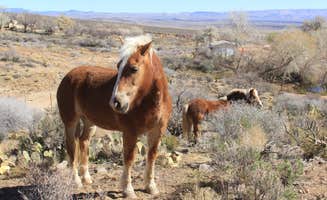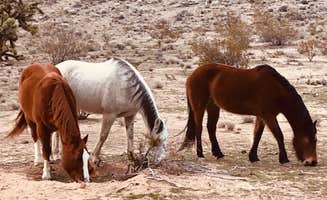Gold Butte National Monument offers equestrian camping opportunities across 297,000 acres of remote Nevada desert terrain. Located approximately 2.5 hours northeast of Las Vegas, the area features numerous side canyons with elevations ranging from 1,200 to 8,000 feet. Summer temperatures regularly exceed 100°F between June and September, while winter nights can drop below freezing.
What to do
Explore petroglyph sites: Ancient rock art can be found throughout Gold Butte National Monument's backcountry. "The area also has several great petroglyph sites," notes Jeff R. about Whitney Pockets, Nevada.
Visit hidden water features: Deeper into the monument, search for natural water sources. Jacob M. recommends exploring Gold Butte's "hidden damn and horse trough that's pretty cool to see" at Gold Butte National Monument.
Scenic driving: Travel the historic mining routes that crisscross the region. "Gold Butte Road is an old mining road that goes many miles into the NE area of Lake Mead," explains Jeff R., though he cautions visitors must "have good tires and high clearance" due to rough conditions.
What campers like
Remote camping locations: The sense of isolation draws many visitors to these equestrian campgrounds near Overton, Nevada. Meghan B. reports staying "3 nights further in the monument with the place mostly to ourselves—one other camper one night and some OHVers and scenic drivers throughout the day."
Colorful geology: The distinctive rock formations create a unique camping backdrop. "We love this area for the colorful red and white sandstone formations that dot the landscape," writes Jeff R. about BLM Whitney Pockets - Falling Man Camp.
Night skies: The lack of light pollution creates excellent stargazing conditions. At Happy Trails Campground & Mini Motel, Aimee K. notes it's "excellent for star gazing" with "beautiful views and very peaceful" surroundings.
What you should know
Weather considerations: The desert climate demands preparation. Michael G. describes how "sight seeing was cut short because of the wind. Getting out of the vehicle was always work. Will have to come back when the conditions are better."
Cell service limitations: Communication can be challenging. Meghan B. mentions "cell service is sporadic—typically have to climb a mountain/hill if you need reception" at Gold Butte.
Water access: No reliable water sources exist in most areas. At Eight Mile Dispersed Camping near Government Wash, Kiley S. notes that "cell signal is booming @ this site, more so than Govt Wash which is across the way," providing a reliable communication option for equestrian campers.
Access challenges: Roads deteriorate significantly after rain. "You definitely cannot camp here in the rain. It's a wash...so that would get dangerous," warns Jamie H. about Eight Mile Dispersed Camping.
Tips for camping with families
Prepare for self-sufficiency: Pack all essentials as services are minimal. Michael B. explains that "while camping at Lake Mead, you can opt to stay in there campground that has electrical hookups, but we prefer to boondock."
Consider alternative locations: For families needing more amenities, developed campgrounds provide better options. At Las Vegas Bay Campground, Amy G. found their site "quiet, shaded and beautiful. Lot of palms and oleander that gave a lot of privacy," noting that "drinking water was available too."
Wildlife viewing opportunities: The desert ecosystem offers educational experiences. Lance E. mentions "at night I've always heard coyotes and owls" at Las Vegas Bay Campground, adding that "many of the sites have great views."
Tips from RVers
Trailer size limitations: Most dispersed horse camping areas have space constraints. Jeff R. explains that at Whitney Pockets "some camp sites will accommodate large RVs" but "most can accommodate around 30 feet or less."
Road preparation: Ensure your vehicle can handle rough terrain. Jeff R. warns that access "must have good suspension" as the "road into the area is partially paved but has many deep potholes."
Seasonal timing: Plan your equestrian camping trip during milder months. At Paiute Wilderness Area, Ralph S. recommends being prepared, noting "it's as remote a place as I've found to camp without going deeper into GC Parashant," emphasizing that visitors should "BE SURE YOU'RE PREPARED!"



